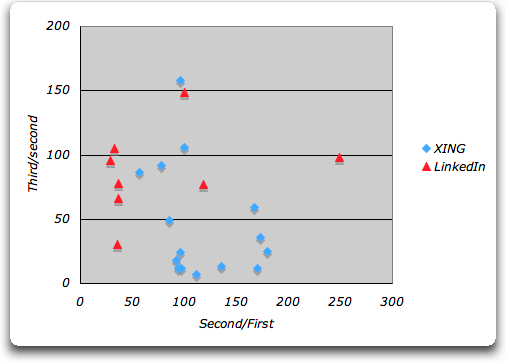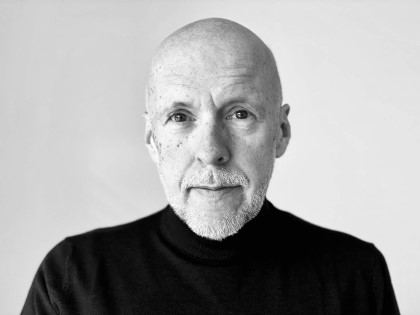Social network statistics
by Volker Weber
I would like to take a look at the data of social networks. Unfortunately I don't have much information I can play with, so maybe you are able to help a little bit.
Let's take a look at my network on XING:
I have 883 contacts, who in turn have 83,432 contacts, or 94 each. If each of those would have another 94 contacts, then my third degree contacts should be more than 7.8 million. But there are only about 1 million. As a matter of fact, XING only has 4 million members. Anyway, for each second degree contact there are only 12 third degree contacts.
Another person I asked has 845 contacts, 82,138 second degree contacts, and also 1 million third degree contacts. So it's again 94 contacts for each first degree contact, and then a similar ceiling for the third degree.
Next up is a person with 1651 contacts, and 185,707 second degree contacts. That is 112 contacts for each first degree contact, but he only has 1.2 million third degree contacts. 6 third degree for each second degree. Double the first, more than double the second degree but only plus 20 percent on the third. It appears we are hitting either a ceiling of connected users, or there are at least two islands within the community.
First question is how does the network count those contacts? If I know two people and they each have 40 connections, but 20 of them overlap, do I then have 60 second degree contacts or 80?
In the light of this question, it appears that XING only counts additional contacts and eliminates the overlap. A person with 185,000 already "knows" 20% of the network. Those all know the rest with a great overlap. (Let's not look at the fact that it is impossible to know whom your 1651 contacts know.)
Second question: how many members of XING's 4 million base have more than a handful of contacts?
Now let's take a look at LinkedIn. There I have 346 first degree contacts and 12,800 second degree. That is only 37 contacts for each on my contacts. But on the third degree things look better than on XING, because I have 841,700 or almost 66 per second degree contacts.
Without any other data points there are only two possible explanations. Either all the other people are better connected than my contacts, or (and I find this more likely) LinkedIn does not eliminate the overlap and the numbers project a much larger network than exists.
Your thoughts?
Update: I started collecting some data points from the comments:

Comments
good point!
just for your stats: 67-3819-328.158 on xing
ebenso, xing: 42 - 3.286 - 300.838
Does XING have anything like the LinkedIn phenomenon where certain people will connect with anyone who asks them to, and they include their email address in their profile to make it easy? These people have thousands upon thousands of contacts, and if you connect with some of them in your second degree (likely) then your third degree will balloon all out of proportion. It's not a true measure of social networking, because they're gaming the system.
XING does have this phenomenon aswell, but in a different twist.
It is actually quite easy to connect on XING. You don't need an email address. While you look at a person's profile, you see only so much of their information, but you can immediately send a connection request. When the other person accepts, then (s)he will reveal profile information on a case-by-case decision. In that respect it is much easier to re-connect long lost contacts.
Since it is so easy to connect, there is no incentive to game the system. However, there are some people who collect thousands and thousands of contacts and then spam them.
Having said that, it would explain, why LinkedIn shows a different behavior for me. It may only be one of my second degree contacts who is promiscuous. Actually I have an idea who that is.
Volker, Xing eliminates the overlap. I know for sure.
Now I found it, Volker:
read the second comment in the thread from Lars Hinrichs as an answer to my same question:
lars hinrichs wrote on Apr 15, 2007 11:53:21
"Es sind nicht weniger geworden, wir haben nur die Doppelungen rausgenommen. Wenn Sie zwei Personen kennen, die wiederum zwei gleiche Kontakte haben ist es für uns jetzt nur noch 1 Kontakt - egal über welche Route sie gehen."
;-)
Xing:
110 - 19'026 - 675'462
LinkedIn:
13 - 1300 - 194'100
Xing: 176 - 31696 - 797286
Linkedin: 177 - 20800 - 1,598,700
In my case, I believe the geographic distribution of other users is a key factor. In Xing, most of my contacts are from Germany (155), whereas in LinkedIn, my contacts are primarily in the US, Australia and the UK.
Independent from how Xing and Linkedin count overlapping users, in my case it is just more likely that the contacts of my contacts overlap a lot less if they are spread across 3 continents rather than one small country.
(note that I have 30% less 2nd degree contacts on Linkedin, but almost 100% more 3rd degree users.
Xing: 346 - 33.256 - 808.836 (so it is 96 second contacts for each first and 24 third for each second)
LinkedIn: 49 - 1,800+ - 139,600 ( 37 second for first, 77 third for second)
My guess is, that the stats differ mainly for two reasons - first, the geographical dispersion - Xing is very focused in Germany and after the acquisitions they made, also in Spain and Latin America (I would suspect that the cause for unconnected islands may lay here, if there are any)
second is the size: Linked in proximally 3 times as big as xing (11 to 4 million users), so if you would find someone (who is not promiscuous) who have three time as much contacts on linkedin than he have on xing - than you could compare the results and make "scientific" measurements.
Xing: 49 - 8199 - 483.255 ( 167 second for first, 59 third for second )
@Vowe the graph is cool! I hope some more people will contribute their stats (do it in private mail to vowe if you prefer not to disclosure yourself)
Volker, what do you want to prove? I didn't quite understand it.
I am still discovering ...
LinkedIn: 98/2800/267400
XING: 22/2199/234125
Xing: 131 - 11.315 - 554.910
LinkedIn: 11 - 400 - 12,100
Xing: 3 - 288 - 45.592 ;-)
Xing: 593 - 80.875 - 1.021.293
just to please you :-)
XING: 557 - 51.018 - 911.725
LinkedIn: 57 - 1.900 - 199.600
Just for your graph ;-)
Xing: 489 - 83.132 - 1.027.757
LinkedIn: 39 - 9.700 - 946.200
pleading for an open social network stats standard ;)
LinkedIn: 167 - 37,800+ - 2,083,000+
ratios: 1:226 & 1:55
XING: 33 - 3587 - 316621
[X] Yes, please keep me informed about future studies.
Xing: 66 - 7.370 - 460.232
LinkedIn does not really count, I only recently registered. So there are 3 real contacts, the rest is somewhat made up by LinkedIn: "300+" and "12,000+", which basically probably means 'quite a few people'.
XING: 285 - 29376 - 779029
LinkedIn: 53 - 1400 - 123600+ (BTW: Why "+"? They don't know exactly how many?)
Xing
477 - 97312 - 1064488
1/2: 204
2/3: 11
LinkedIn: 0
"[X] Yes, please keep me informed about future studies."
LOL:)) @Lennard, good one.
Xing: 54 - 5.578 - 402.002
xing: 570 - 79146 - 1.016.000
1/2: 138 (ok ich hab Marco R. drin ;) )
2/3: 12
linkedin: 123 - 7900+ - 641100+ also wohl auch Schätzwerte.
1/2= 64 2/3=81
Also wenn nicht der Geografische 'Speizeffekt' auftritt, dann scheint deine These korrekt.
'Sozial' relevant scheint mir ab eh nur die Zahl primärer und sekundärer Kontakte zu sein.
Ist das nicht aufwendig, die zu kalkulieren? macht Xing das bei jedem add neu?
(bin das nur ich oder sieht dei grafik nicht so aus als würde sie schon was sagen?)

